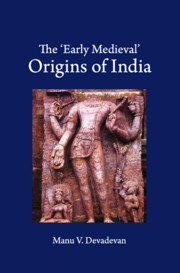Book contents
- Frontmatter
- Dedication
- Contents
- List of Tables
- List of Maps and Figures
- Acknowledgements
- 1 Introduction
- I INSTITUTIONS
- 2 State Formation and Its Structural Foundations
- 3 From the Cult of Chivalry to the Cult of Personality: The Seventh- Century Transformation in Pallava Statecraft
- 4 Changes in Land Relations and the Changing Fortunes of the Cēra State
- 5 Temple and Territory in the Puri Jagannātha Imaginaire
- II IDEAS
- 6 Svayaṃbuddha's Predilections: The Epistemologies of Time and Knowledge
- 7 Bhāravi and the Creation of a Literary Paradigm
- 8 Knowing and Being: The Semantic Universe of the Kūḍiyāṭṭaṃ Theatre
- 9 The Invention of Zero and Its Intellectual Legacy
- III IDENTITIES
- 10 The Evolution of Vernacular Languages: A Case Study of Kannada
- 11 Religious Identities in Times of Indumauḷi's Grief
- 12 Caste, Gender, and the Landed Patriarchy
- 13 The Making of Territorial Self Consciousness (with Particular Reference to Kaliṅga)
- Bibliography
- Index
10 - The Evolution of Vernacular Languages: A Case Study of Kannada
Published online by Cambridge University Press: 02 May 2020
- Frontmatter
- Dedication
- Contents
- List of Tables
- List of Maps and Figures
- Acknowledgements
- 1 Introduction
- I INSTITUTIONS
- 2 State Formation and Its Structural Foundations
- 3 From the Cult of Chivalry to the Cult of Personality: The Seventh- Century Transformation in Pallava Statecraft
- 4 Changes in Land Relations and the Changing Fortunes of the Cēra State
- 5 Temple and Territory in the Puri Jagannātha Imaginaire
- II IDEAS
- 6 Svayaṃbuddha's Predilections: The Epistemologies of Time and Knowledge
- 7 Bhāravi and the Creation of a Literary Paradigm
- 8 Knowing and Being: The Semantic Universe of the Kūḍiyāṭṭaṃ Theatre
- 9 The Invention of Zero and Its Intellectual Legacy
- III IDENTITIES
- 10 The Evolution of Vernacular Languages: A Case Study of Kannada
- 11 Religious Identities in Times of Indumauḷi's Grief
- 12 Caste, Gender, and the Landed Patriarchy
- 13 The Making of Territorial Self Consciousness (with Particular Reference to Kaliṅga)
- Bibliography
- Index
Summary
Towards the close of the fifth century CE, the Gaṅga king Avinīta made a land grant at Mallōhaḷḷi near Doḍḍabaḷḷāpura to Kāḍasvāmi, a brāhmaṇa from Tippūru in Maṟugeṟe Rāṣṭra. Unlike inscriptions produced in the subcontinent until then, which were invariably in Prakrit, Sanskrit, and Tamil, this grant composed in most parts in Sanskrit was interspersed with two brief portions in Kannada. They read: ‘maṟugeṟeya rāṣṭṟa tippura kāḍasvāmigaḷge brahmadēya kṟamadin [me]lura [keṟe] kīḻe pa[nnir] khaṇḍuga’ and ‘rggaḻaninda pannirkkaṇḍuga vedenel maṇṇuṃ ondu pāḻuṃ…ra paḍedaṃ paḍedōnaṟaṃ’. This may be the earliest sample of the language extant today. There are, however, the words koḍalarā (kūḍalūrā) nāgaṃṇanā kṛtamidaṃ (‘composed by Nāgaṇṇa of Kūḍalūru’) occurring in another inscription composed in Sanskrit, the Hāsana Plates of Avinīta's father, Mādhavavarman III. Here, the letters rā and nā at the end of the first two words display Kannada case ending for the genitive case. The suffix in the composer's name, aṇṇa, elder brother, and the words kūḍal, confluence, and ūru, village, which together form the place name, are clearly Dravidian.
Not long thereafter, Cēnūrukāju, a functionary of the Rēnāṭi Cōḷas, commissioned an inscription at Kalamalla in the Kaḍapa district of Andhra as part of what appears to be a land grant. The purports of this worn-out record from the sixth century cannot be clearly ascertained, but it is obviously the earliest surviving sample of Telugu. It reads: kal mu[tu]rāju dhanañjayu rēnāṇḍu ēḷan ciṟuṃbūri rēvaṇakālu [paṃ]pu cēnūrukāeju] aḻikaḷālūri[ṇḍa] vāru ūri … pañcamahāpātakas… ku. Inscriptions in Tamil have a longer history that goes back to the late centuries BCE. Numerous short labels and epigrams engraved on cave walls, rock surfaces, and pottery have come to light from several locations across Tamil Nadu and Kerala. They record the names and titles of a number of individuals, who are mostly chiefs, merchants, and monks. There is no gainsaying, in any case, that the first major epigraphic use of Tamil is in the two Pūlāṅkuṟicci inscriptions of the late fifth or early sixth century. These are records of land grants. A qualitative change in the epigraphic use of Tamil is noticed here. The Paḷḷaṅkōvil Plates of the late-sixth-century Pallava king Siṃhavarman IV use Tamil to record the details of a grant, making it the first Pallava inscription to employ this language. Unlike Kannada and Telugu though, the Pūlāṅkuṟicci and Paḷḷaṅkōvil Inscriptions are not the oldest surviving vestiges of Tamil.
- Type
- Chapter
- Information
- The ‘Early Medieval' Origins of India , pp. 281 - 305Publisher: Cambridge University PressPrint publication year: 2020



